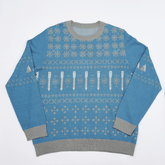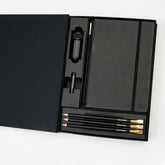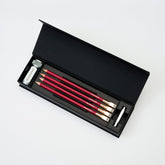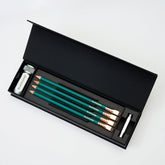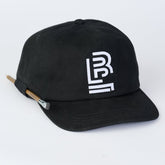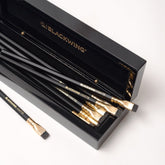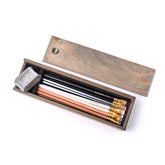Makers Series — Heather Martinez
Meet Heather Martinez, lettering aficionado
When we first featured Heather Martinez in our Makers Series, we highlighted her passion for artistic lettering and her dedication to inspiring others through her innovative mark-making techniques. Since then, Heather has continued to expand her impact as a teacher, visual practitioner, and lettering expert—guiding learners of all ages to express their creativity through the art of letters.

Today, we’re thrilled to share that Heather partnered with Blackwing Foundation as collaborator of Pathways to Creativity: Lettering Series. This classroom-ready program introduces students in 3rd grade and beyond to the art of lettering, helping learners develop their own style and voice through written expression.
The Lettering Series brings Heather’s expertise directly into classrooms across the country. Each pathway includes a simple, printer-friendly packet and step-by-step video lessons taught by Heather herself. Students need only a pencil and paper to get started, making the program accessible for teachers everywhere.

The first two pathways, Introduction to Lettering and Letter Like a Graphic Novelist, are already live, with additional pathways—including Intro to Cursive, Creative Styles, and Brush Lettering—coming soon. Beyond the lesson videos, Blackwing Foundation designed supplemental resources that provide students with concrete ways to practice and refine their new skills.

Heather’s collaboration with the Blackwing Foundation embodies her lifelong mission: helping others express their creativity in meaningful ways. Through the Lettering Series, her influence is reaching a new generation of students—empowering them to explore the art of lettering and discover the power of their own written voice.
Learn about and support Heather.
Read the original interview:
What do you do?
I try to learn as many lettering styles and creative processes as I possibly can. Having an insatiable appetite for information, I have had the great fortune to study with master calligraphers, artists, and seasoned process facilitators. I try my very best to turn that into meaningful work. Meaningful to me means to be in the presence of and to support those who seek change. As a lettering artist and visual practitioner, I use my ability to capture what’s happening in the present moment. As an Appreciative Inquiry facilitator I’m fascinated with the strengths and passions of others and what they can create in collaboration. And the role most personal to me, as an artist I practice and explore process, concepts, the relationships between ideas, and the creative tension that serves as an impetus to get something accomplished.

What does your work space look like? Where do you like to create?
As a visual practitioner I have found myself working in the most peculiar places from the beach in the Dominican Republic, penthouse boardrooms overlooking the city, to secured facilities with no windows at all. While I have two primary personal workspaces—a home office and shared art studio—where I like to create the most is in the classroom and in meeting rooms where people gather to co-create their future.
What role does the pencil play in your process?
The pencil is not only my favorite mark-making tool (next to my 1969 Olivetti Valentine typewriter) it’s also a symbol of what is possible. When I pick up a new pencil, I welcome it into my process and thank it for all of the ideas it will inspire and support. I also admire how it was crafted and wonder where the graphite was sourced.
When I am nervous before a big project, especially when I have hung my paper in front a group of people and I wait for the event to begin, I find comfort in the ritual of picking up my favorite pencil sharpener and sharpening my pencil. It reminds me to stay “sharp” and usually sits behind my ear as I work. I rely on it to sketch out ideas before I commit them to ink.
And as a lettering artist, I love creating letters using pressure-release techniques.

Why do you choose to work with pencils and, specifically, Blackwings?
Of all of the pencils I have ever sharpened, the Blackwing pencil is the most satisfying to work with. The impeccable placement of graphite allows for an admirable collar—the wood-exposed space between the sharpened graphite and the painted shaft—regardless if I’m using a single blade sharpener, single burr sharpener or enjoying the process of sharpening with a hand blade like a box cutter or the “Little Shaver.”
While I have a personal relationship with the pencil, I like using it in front of others too. I always get compliments and I like the way it sounds when it glides across the paper. Sometimes I can be dramatic about sketching out ideas in front of clients.
What other tools are essential to your process?
As a visual practitioner I use Neuland markers on paper and Adobe Draw on the iPad.
As a calligrapher I have many tools but the handcrafted folded pen, brush, and walnut ink are my go-to tools.
As an artist I have enjoyed every medium but have an affinity for printmaking and mixed media works on paper.

How do you overcome a creative block?
Honestly, I usually have so many projects going on that I use them to avoid blocks. That can be very dangerous because that results in procrastination and denial of real work. When I get to my breaking point, I turn to the Shift-It® Process to self soothe and coach myself out of overwhelm. I’m always surprised at the amount of tension that can build from avoidance and what great ideas and transformation comes from the process.
What’s the best advice you’ve ever received?
Two mentors in my life said nearly the same thing to me early on in my studies with them that has helped my self-confidence. Leslie Salmon-Zhu empowered me for my first graphic recording gig by saying, “Your are the only one in the room with the markers and have the power to do the important work you are there to do.” And master calligrapher Carol DuBosch offered this advice in a workshop, “You are the artist with the tool in your hand.”
I hope others remember the power of the tool they are working with and what can be inspired and influenced by understanding the responsibility that comes with it.
You can support Heather on her website letslettertogether.com and her Instagram.
